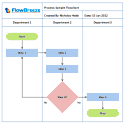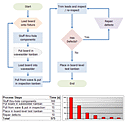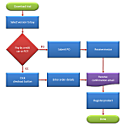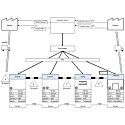How to Create Flowcharts in Excel Series
The Top 7 Reasons to Flowchart with Excel
By Nicholas Hebb
As makers of a flowchart add-in for Excel, we're often asked "Why flowchart in Excel?". To some people, using a perfectly good spreadsheet application as a flowchart drawing tool is a hack at best and a bastardization at worst. But if you're a small business owner or run a lean operation, you owe yourself a look at the flowchart tools built into Excel (as well as the other Microsoft Office applications) because it can save you a lot of time, money, and headaches down the road.
Excel Flowchart Wizard
FlowBreeze is a flowchart add-in for Microsoft Excel that makes creating flowcharts simple and pain free. Free 30-Day Trial.The following are the top seven reasons for creating Excel flowcharts:
-
Cost: The first and most obvious reason to flowchart in Excel is cost. If you already own a
copy of Microsoft Office, then you have a built-in flowcharting tool that you may not even have known
about. Free is a pretty good price.
-
Capability: Most of the big name, expensive flowcharting programs on the market are chock
full of symbols. They have plumbing symbols, electrical symbols, medical symbols, and all kinds of other
symbols that you'll never use. Meanwhile, Excel has all you really need - a standard set of
flowchart symbols, flow lines (aka connectors), and callouts. Excel even has a little known snap to grid
function, and by changing the column widths, you can easily set up a flowcharting environment like the
expensive tools.
-
Standardization: If you've ever been through a merger or acquisition, or if you've worked
somewhere where employees have each picked their own favorite drawing tool, you know what a pain it can
be to maintain them all. Either the person that created a flowchart gets to maintain it for life, or the
company needs to buy multiple copies of each type of flowchart software used. Otherwise, you end up
re-creating the flowchart every time some small change needs to be made. By making Excel the standard
flowchart tool, this becomes a non-issue.
-
Portability: Flowcharts created in Excel are portable among Office documents. A flowchart
created in Excel can be embedded in Word or PowerPoint and be edited in place. Some people may scoff at
this being labeled portability, but with over 400 million Microsoft Office users worldwide, that's
pretty darn portable.
-
Document Control: If you work for a company that controls its documentation (e.g., for ISO
9000), then flowcharts that are published in other documents become a version control issue. Often
authors create the flowchart in a 3rd party program and paste a picture in the document. What happens
when the author switches positions, leaves the company, or just plain can't find the original flowchart?
It's a similar problem to the Standardization issue. Any time a flowchart changes, it needs to be
re-created from scratch. But because of the portability of Excel flowcharts among Office documents, a
flowchart created in Excel and published in Word is completely under document control. Maintaining the
original Excel copy isn't even necessary.
-
Collaboration: If you need to do long distance collaboration with a co-worker, customer or
vendor on a process definition, then going back and forth can be a real hassle. But if you're not even
using the same tools to diagram the process, it gets even worse. You create the flowchart, email them
a picture of it, they print it out and mark it up, and then send the image back.
Using Excel makes this so much easier. As said above, there are millions of Offices
users, so odds are, you can collaborate much more easily by keeping you business process diagrams in
Excel.
-
Analysis: Flowcharts are a great tool for visualizing a business process. But if you really
want to analyze a process for continual improvement, then being able to annotate the process steps with
data helps. Excel lets you create a process map that includes process metrics. You can create a grid
with all the process inputs and outputs on the same sheet as the flowchart, plus tabulate the data.
And finally a bonus reason: You and/or your employees are probably already familiar with the Excel user interface. With much of the flowchart software on the market, conquering the learning curve is half the battle. With the Excel flowchart tools, you can be up to speed creating flowcharts in no time.
About the Author
Nicholas Hebb
Nicholas Hebb is the owner and developer of BreezeTree Software, makers of FlowBreeze Flowchart Software, a text-to-flowchart maker, and Spreadspeed, an auditing and productivity toolset for Microsoft Excel®.



